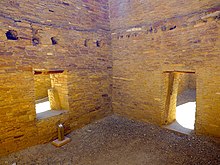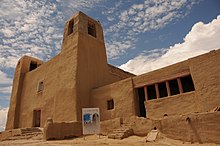Pueblo architecture
Pueblo architecture refers to the traditional architecture of the Pueblo people in what is now the southwestern United States, especially New Mexico. Many of the same building techniques were later adapted by Spanish colonists into a regional form of Spanish Colonial architecture. Pueblo architecture was also the basis for Pueblo Revival architecture, a 20th-century regional revival style that remains popular.



History
Ancestral Puebloan people first began building pueblo structures during the Pueblo I Period (750–900 CE). When Spanish colonists arrived in the Southwest beginning in the late 1500s, they learned the local construction techniques from the Pueblo people and adapted them to fit their own building types, such as haciendas and mission churches.[1] The Pueblo people also adopted some of the Spanish innovations, including manufacture of sun-baked adobe bricks.[2] As modern building materials like brick, glass, and milled lumber became more available during the Territorial period and especially with the arrival of railroads in the 1870s and 1880s, the traditional construction methods fell out of favor, though they remained commonplace in rural areas. Pueblo architecture experienced a resurgence in the 1920s and 1930s as a romanticized revival style, Pueblo Revival, and remains popular in New Mexico.
Characteristics
Pueblo buildings are most commonly constructed from adobe, though stone was also used where available, for instance at Chaco Canyon. The buildings have flat roofs supported by rough-hewn wooden beams called vigas and smaller perpendicular laths or latillas. The vigas typically extend through the exterior wall surface. Larger structures often take the form of multistory terraces with setbacks at each level. Traditionally, upper floors were accessed by ladders, and buildings were often semi-fortified with minimal door and window openings at ground level. Other key elements of Pueblo architecture include kivas, which are circular ceremonial rooms which are partially or fully below ground, and enclosed courtyards or plazas.[3][4]
References
- Bunting, Bainbridge (1976). Early Architecture in New Mexico. Albuquerque: University of New Mexico Press.
- Markovich, Nicholas C.; Preiser, Wolfgang F. E.; Sturm, Fred G. (2015). Pueblo Style and Regional Architecture. New York: Routledge. p. 20. ISBN 978-1-317-39883-7. Retrieved June 13, 2020.
- Lekson, Stephen H. (1984). Great Pueblo Architecture of Chaco Canyon (PDF). Albuquerque, NM: National Park Service. Retrieved June 13, 2020.
- "Pueblo architecture". Encyclopædia Britannica. Retrieved June 13, 2020.